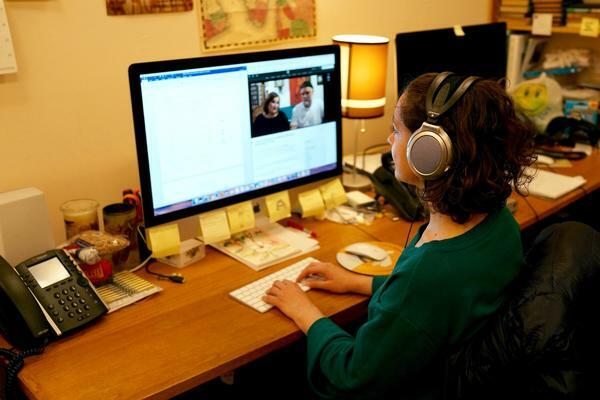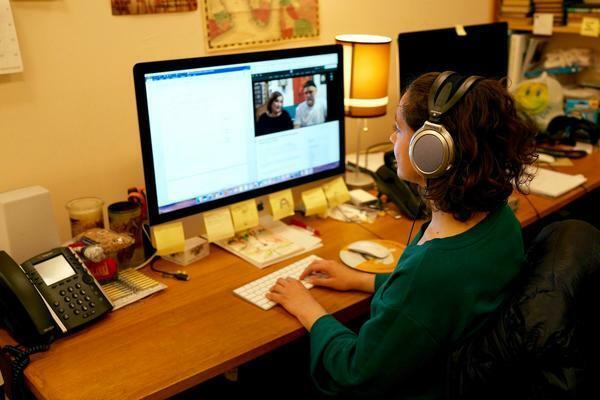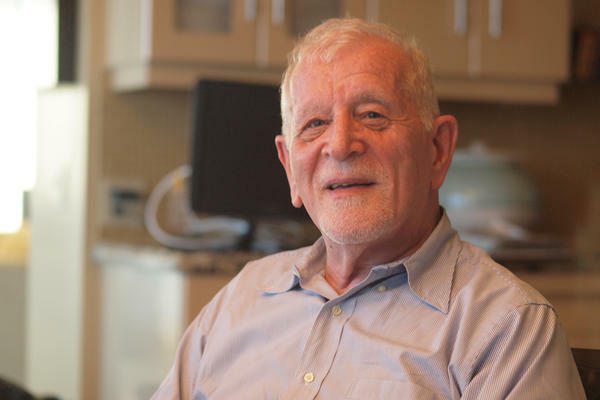Q&A with Carole Renard on Enhanced Oral History Access
NEH Project Coordinator on New Ways to Search and Browse Oral History Collection
In 2017, the Yiddish Book Center was awarded a major grant from the National Endowment for the Humanities (NEH) Division of Preservation and Access to enhance access to a portion of the Center’s Wexler Oral History Project interview collection. As part of this project, we transcribed 400 interviews, created timecoded indices of over 600 interviews (including bilingual indices for over 150 Yiddish-language interviews, as well as Spanish-, Polish- and Russian- language interviews in our collection), and created a thesaurus of keywords, gathering alternate spellings from widely used encyclopedic sources. These new features will make our oral histories more accessible both to the general public and to students, researchers, language pedagogues, filmmakers, and journalists, for whom these interviews serve as a valuable source of primary material on Yiddish and Jewish language and culture.
To learn more about these features, visit the user guide to the Wexler Oral History Project collection.
Christa Whitney talks to NEH project coordinator, Carole Renard, about the grant work and new features on our website:
Christa Whitney: What was your favorite part of working on this project for the past few years?
Carole Renard: It’s so difficult to choose just one! One of the aspects that I really loved was getting to delve into the collection so deeply. Working on transcribing and indexing oral history interviews means going through each interview many times and getting to connect really closely with the narrators and their stories. I also enjoyed collaborating with you and our colleagues. It was fun and fascinating to grapple with the different challenges that arose, especially when working on the non-English portions of transcripts.
CPW: Yes, it was really fun to work collaboratively like that. Trying to hunt down obscure references and also trying to transcribe the different Yiddish dialects accurately was both challenging and fun, too! A large portion of the work on this grant was creating transcripts of 400 oral history interviews in our collection. What is valuable about having the transcripts available?
CR: Well, first of all, they offer another way of preserving the collection. We have our transcripts both digitally and in paper form, and it’s reassuring to know that we have this other way of saving these interviews. They’re also valuable resources for anyone doing research on a specific topic—the transcripts available on the website are searchable, so people can look for specific words or names and then jump directly to that part of the transcript and interview. And in terms of accessibility in general, it’s really important and helpful to have a written version of the interview, especially as we don’t have closed captions for our full-length interviews.
CPW: I remember transcription was more complicated than we anticipated when we started out. And, as we’ve learned, transcription is a subject of much discussion in the oral history field and beyond. Now that you’ve helped create, review, and publish 400 interviews, you’ve had plenty of experience with the joys and pains of transcriptions. What makes transcription so interesting and challenging?
CR: There are so many nuances to hold when transcribing oral history interviews in particular, I think. One aspect that’s both interesting and challenging is that transcribing the spoken word always means a certain level of editorializing, from the spelling of words down to the punctuation used. You have to make decisions about how much to reflect different dialects and accents, when to include false starts, how to reflect fragmented sentences . . . People don’t speak the way they would write, and so recording speech in written form demands a lot of different decisions that I hadn’t anticipated. For example, we started out doing verbatim transcripts and quickly realized that including every “um” and “uh” made the transcripts difficult to read. It was interesting to think through how to reflect speech as accurately as possible while also creating a document that would be readable and useful, and to consider how to involve various people in those decisions.
CPW: Another major part of the project was creating timecoded indices for over 600 interviews. What does having these indices published add to the collection?
CR: The indices add a whole other dimension to the accessibility of the collection. First of all, they provide a table of contents of sorts for each interview, so viewers can scan through the segment titles to get a sense of what is covered in the interview. Each segment also has a list of keywords that are relevant to that particular part of the interview, which offers more information about the contents of the interview. And the indices are searchable, which means that, a bit like the transcripts, someone researching a particular topic could search for keywords related to that topic, see where those come up in the interview, and then jump to the relevant part(s) of the interview. One way that indices add to the searchability of an interview is that they might include keywords that are related to what is being discussed even if the narrator doesn’t use those particular terms. So, for example, if a narrator is talking about intergenerational transmission but doesn’t use that exact term, someone looking into that subject would still be able to access that part of the interview by searching through the keywords in the index.
CPW: The last big part of this project is making the thousands of photographs, documents, and other artifacts collected along with the interviews available to the public through our website for the first time. What do these add to the collection?
CR: I think the artifacts add a really special and personal dimension to the collection. Of course, oral histories are personal to begin with, but being able to view a photograph of the narrator when they were younger or an image of a poster of a Yiddish performance that the narrator mentions adds another layer of connection to their interview. And then again, these artifacts can also offer valuable additional information for researchers—we sometimes have scanned letters or other documents that contribute information to the story being told in the interview itself. One artifact that comes to mind, for example, is from Daniel Forman’s interview—at the end he read some letters from his grandfather, the Yiddish writer Solomon Simon. To be able to not only see the letters but also hear him read aloud the words that his zeyde had written to him when he was young feels so meaningful and personal.
CPW: I want to ask a slightly different kind of question: from your perspective as someone with an academic background as a Jewish cultural historian, what do these interviews add to our understanding of Jewish life in the twentieth and twenty-first centuries?
CR: I think they make our understanding of and relationship with twentieth and twenty-first century Jewish history much more multidimensional. It’s one thing to read about Jewish history (even through primary source documents), it’s another to watch a one- or two-hour-long interview with someone recounting their lived experiences. There’s a really intimate, personal experience in recording and watching oral history interviews, and hearing the stories that people share in them—for instance, someone’s experience of a well-known historical event—enables us to connect to and engage with the history in a completely different, and often deeper, way. Other examples include oral history interviews with the descendants of Yiddish authors, which can add layers of complexity to our understanding of those authors’ works that we might not otherwise have access to. Or narrators who describe Jewish neighborhoods that existed in a particular time, like Leonard Nimoy talking about the West End in Boston—these perspectives add so much texture to our understanding of Jewish culture.
CPW: What uses of the oral history interviews do you imagine these new features could make possible?
CR: I could see them being useful in a lot of ways. I think they’ll be helpful for researchers who are looking into specific topics, as I talked about a little bit earlier. I also know that our interviews have been used in documentary films, museum exhibits, language classes, and other contexts—these enhanced features will make searching our collection easier for people who are using them in whatever way. For example, language pedagogues who might be looking for examples of different Yiddish dialects could search for different geographical terms within our interviews. And more generally, anyone who’s looking through our collection for different reasons—the fact that the timecodes allow viewers to jump to specific parts of the interviews might draw more people to our collection who are looking for specific stories but maybe don’t have time to watch an interview in its entirety. And I think for families of narrators, too, the fact that there are now timecoded transcripts and indices offers a new way of engaging with their family’s stories.
- - - - -
Carole Renard is the Wexler Oral History Project’s coordinator. She began working with the Yiddish Book Center’s Wexler Oral History Project in 2016 as an intern and joined the full-time team in 2017 as the NEH project coordinator. She also conducts oral history interviews for the Project. Carole holds a BA from Smith College in anthropology and Jewish studies and an MA from University College London in Jewish studies.
The Wexler Oral History Project is a collection of video interviews about the legacy and changing nature of Yiddish language and culture. Since 2010, we’ve collected over 1,000 interviews with people of all ages and backgrounds, whose stories offer a rich and complex chronicle of Jewish identity. Explore the collection.



